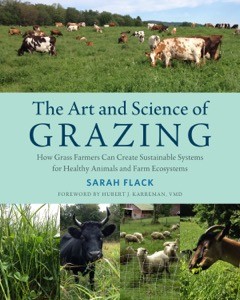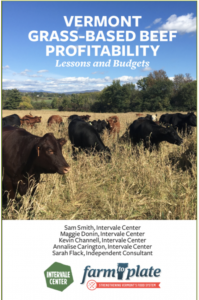BOOKS
Books:

The Art and Science of Grazing
How Grass Farmers Can Create Sustainable Systems for Healthy Animals and Farm Ecosystems
Grazing management might seem simple: just put livestock in a pasture and let them eat their fill. However, as Sarah Flack explains in The Art and Science of Grazing, the pasture/livestock relationship is incredibly complex. If a farmer doesn’t pay close attention to how the animals are grazing, the resulting poorly managed grazing system can be harmful to the health of the livestock, pasture plants, and soils. Well-managed pastures can instead create healthier animals, a diverse and resilient pasture ecosystem, and other benefits. Flack delves deeply below the surface of “let the cows eat grass,” demonstrating that grazing management is a sophisticated science that requires mastery of plant and animal physiology, animal behavior, and ecology. She also shows readers that applying grazing management science on a working farm is an art form that calls on grass farmers to be careful observers, excellent planners and record-keepers, skillful interpreters of their observations, and creative troubleshooters. The Art and Science of Grazing will allow farmers to gain a solid understanding of the key principles of grazing management so they can both design and manage successful grazing systems. The book’s unique approach presents information first from the perspective of pasture plants, and then from the livestock perspective—helping farmers understand both plant and animal needs before setting up a grazing system. This book is an essential guide for ruminant farmers who want to be able to create grazing systems that meet the needs of their livestock, pasture plants, soils, and the larger ecosystem. The book discusses all the practical details that are critical for sustained success: how to set up a new system or improve existing systems; acreage calculations; paddock layout; fence and drinking water access; lanes and other grazing infrastructure; managing livestock movement and flow; soil fertility; seeding and reseeding pastures; and more. The author includes descriptions of real grazing systems working well on dairy, beef, goat, and sheep farms in different regions of North America. The book covers pasture requirements specific to organic farming, but will be of use to both organic and non-organic farms.
You can order a copy of this book directly from Chelsea Green Publishing. They offer discounts for volume purchases and can also help with book sales at conferences. You can also order from your local bookstore, or from Amazon
You can also buy a copy of The Art and Science of Grazing here for $35.00 with free shipping in the United States. If you’d like a signed copy, just ask. To order, send a check or money order payable to Sarah Flack for $35.00 and include the address you want it shipped to. Sorry, we do not accept credit cards.
Send check or money order to:
Sarah Flack book orders
PO Box 53
Fairfield VT 05455
Books are shipped as soon as we receive payment.
A Farmers Guide to Grass Fed Dairy Production This publication is based on many years of learning through the Northeast Grass Fed Dairy project which includes ongoing research, outreach and working alongside our wonderful farm partners. The guide walks you through the ins and outs of grass-fed dairying from soil fertility and nutrient cycling, to forage production and quality, herd health and reproduction, farm financials, and more. You can find it digitally on our Grass-fed Dairy website or request an in-print copy by contacting Sara Ziegler at sara.ziegler@uvm.edu. You can learn more about the grass fed dairy project, which is part of Dr Heather Darby’s work at the University of Vermont.
Grass Fed Beef Profitability: Lessons and Budgets
by Sam Smith, Maggie Donan, Kevin Channell, Annalise Carrington and Sarah Flack
A free guide for understanding the variables and practices that influence grass-fed beef production profitability, with example budget templates for calculating income, expenses, and profitability. You can download this publication for free. The full budgeting tool can also be downloaded as an excel file.
Other books and where to order them:
Organic Dairy Production
Organic Dairy Production by Sarah Flack can be ordered
http://www.chelseagreen.com/bookstore/item/organic_dairy_production:paperback
“Healthful organic milk comes from healthy cows…which come from good livestock management including access to high-quality stored forages (hay, silage) and pastures. Which in turn come from healthy soils. The quality of these elements all depend on the observation skills and practices of the farmer…”
In chapters on soils, plants and livestock, Flack describes practices developed on farms which are managing successfully under organic principles. There’s an overview of the many preventive and treatment health options available, descriptions of how to manage soils, crops & pastures and advice for marketing fluid milk and value-added dairy products. Organic Dairy Production discusses the regulations governing both milk and value-added production, labeling and sales. Profiles of individual farms help shed light on aspects of dairying and value-added production.
The Organic Dairy Handbook & Workbook
 The Organic Dairy Handbook, A Comprehensive Guide for the Transition and Beyond
The Organic Dairy Handbook, A Comprehensive Guide for the Transition and Beyond
A whole farm management resource for farmers interested in organic production. The handbook is a complete survey of proven options for all aspect of organic dairy management including two major risk sources: the management of herd health and animal nutrition. This handbook outlines the practical knowledge and systematic understanding necessary for conventional farmers to make a successful transition to organic production, for new farmers to develop a successful organic dairy business and for newly transitioned organic dairy farmers to strengthen their overall farm management. Each chapter features cases studies of successful organic dairy farmers, which demonstrate the many models of successful organic dairies. Tables, charts, and graphs throughout the handbook provide quick reference to important information. Extensive resource lists are also included. Its farmer friendly construction with durable cover and pages combined with a coil binding allows farmers to take it from the kitchen to the barn to the field.
NOFA-NY, 2009. 304pp. Available at the NOFA bookstore »
Transitioning to Organic Dairy, Self-Assessment Workbook
New Guide for Organic Dairy Farmers uses a whole farm approach to the transition process and is based on the experiences of successful organic dairy farmers. The Northeast is an excellent region for pasture-based organic dairy farming; however, the transition period can pose risks to farmers such as the potential for increased cull rates, sharply increased feed costs, decreased milk production, and increased labor requirements. This publication is an interactive resource that gives farmers tools to identify the risks they may face on their own farm throughout the transition to organic production. It also helps farmers develop plans to mitigate those risks. This resource will be useful for conventional dairy farmers interested in learning more about organic production, farmers who have recently transitioned to organic dairy and agricultural professionals assisting farmers in the transition to organic management.
NOFA-NY, 2009. 88pp.


